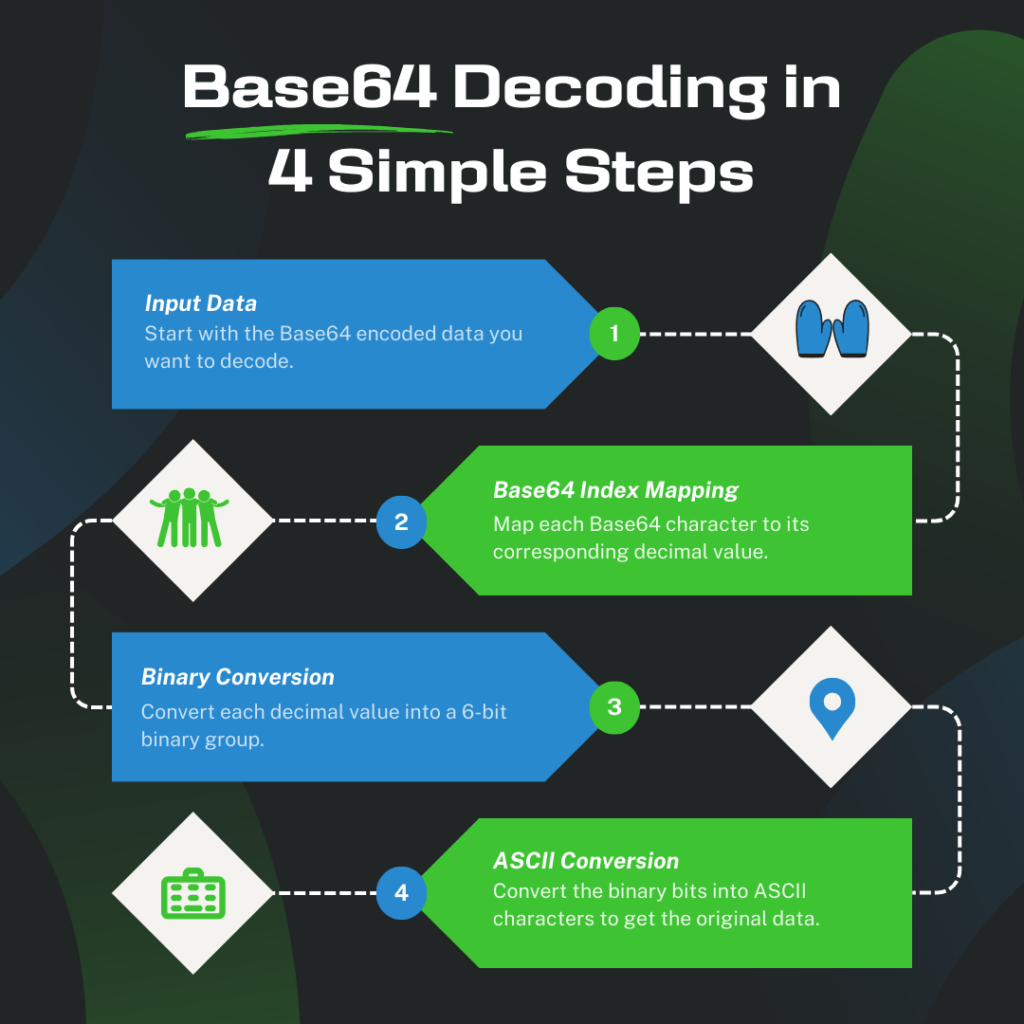In today’s increasingly digital environment, effective data representation is critical. This article goes into Base64 encoding, a technique that is crucial in attaining compactness in data storage and transmission. We’ll look at how it works, why it’s important, and how it may be used in practice.
What is Base64?
Base64 encoding is a basic technique in computer science and data communication. Base64 is, at its heart, a character encoding technique, which means it is a method of representing data using a set of characters.

Here’s a breakdown of what Base64 is all about:
- Character Encoding: Base64 is designed to represent binary data, which computers understand, in a format that is readable by both machines and humans. It does this by converting binary data into a sequence of printable characters.
- The 64-Character Set: The name “Base64” comes from the fact that it uses a set of 64 different characters for encoding. These characters include uppercase letters (A-Z), lowercase letters (a-z), digits (0-9), and often two additional characters (typically ‘+’, and ‘/’). This 64-character set allows for efficient representation of binary data.
- Efficiency and Compactness: Base64 is known for its efficiency in representing binary data in a compact form. It converts complex binary structures into concise text-based strings, making it ideal for various data transmission and storage purposes.
- Padding: In Base64 encoding, padding is often used to ensure that the length of the encoded string is a multiple of 4. Padding is typically done using ‘=’ characters at the end of the string, and it helps in proper decoding to reconstruct the original binary data accurately.
Base64 is a fundamental idea in many areas of computing, including web construction and data transmission, as well as cryptography and encoding various data types such as photos or files. It’s a versatile tool for successfully communicating, preserving, and sharing data in the digital realm.

Understanding Compactness in Data
The concept of compactness in data representation is extremely important in today’s large digital landscape. The efficiency and conciseness with which data is stored, transported, and processed is referred to as compactness. Understanding this principle is critical for improving digital systems, and Base64 encoding is a key component in doing so.
Here’s a closer look at the significance of compactness in data:
- Resource Efficiency: Compact data structures require fewer resources, such as storage space and network bandwidth. This efficiency translates to cost savings and improved performance in various digital applications.
- Data Transmission: In data communication, especially over networks with limited bandwidth, compactness is essential. Smaller data payloads reduce transmission times and decrease the likelihood of errors during data transfer.
- Storage Optimization: Efficient data storage is crucial, particularly in scenarios where large volumes of data need to be stored and retrieved. Compact data representations lead to reduced storage requirements and faster retrieval times.
- Reduced Overhead: Compact data formats minimize overhead, the additional information needed to interpret or process data. This reduction in overhead simplifies data handling and improves system responsiveness.
- Cross-Platform Compatibility: Compact data representations are more likely to be compatible with various platforms and systems. This compatibility ensures that data can be seamlessly exchanged between different environments.
- Practical Use Cases: Compact data formats find applications in numerous fields, such as web development, where smaller web page sizes lead to faster load times; in IoT devices, where data transmission efficiency is critical; and in multimedia, where images and videos are encoded efficiently for streaming.
Base64 encoding is essential for data representation compactness. By translating binary data to text-based format, it gives a more compact version of the original material. This shift is invaluable in situations when data efficiency is critical, as it ensures that digital systems in our data-driven world operate smoothly and effectively.
How Base64 Achieves Compactness
Base64 encoding is a fantastic technique for achieving data representation compactness. It achieves this through the use of a collection of procedures and ideas that maximize the way binary data is transformed into a text-based format. Understanding how Base64 achieves compactness is critical for understanding its utility in a variety of digital applications.
Here’s an in-depth exploration of how Base64 accomplishes compactness:
- Character Set Utilization: Base64 harnesses a specific set of 64 characters chosen from the ASCII character set. This character set includes uppercase letters (A-Z), lowercase letters (a-z), digits (0-9), and often two additional characters, usually ‘+’ and ‘/’. The selection of these characters is deliberate and crucial for efficient data representation.
- Grouping Binary Data: To ensure efficiency and readability, Base64 organizes binary data into groups of 6 bits each. These 6-bit groups are then mapped to the corresponding characters in the 64-character set. Grouping data in this manner allows for precise representation without wasting space.
- Padding for Completeness: To ensure that the length of the encoded string is a multiple of 4, Base64 encoding may add padding in the form of ‘=’ characters at the end. This padding is vital for accurate decoding, ensuring that the original binary data can be faithfully reconstructed.
- Text-Based Output: Base64 encoding transforms binary data into a text-based format composed of the 64-character set. This representation is more efficient in terms of storage and transmission because it avoids the use of non-printable or control characters found in raw binary data.
- Lossless Encoding: Despite its compactness, Base64 encoding is lossless, meaning that it can accurately represent any binary data without loss of information. This quality is particularly important in scenarios where data integrity is paramount.
- Versatile Applications: Base64’s compactness makes it invaluable in various applications, including data transmission in email systems, embedding images in web pages, storing cryptographic keys, and encoding binary attachments in multi-media formats. It ensures that data can be efficiently conveyed across different digital environments.
In essence, Base64 accomplishes compactness by employing an optimized character set, efficiently grouping binary data, and providing padding when necessary. As a result, a text-based representation that balances space efficiency and data fidelity is produced, making it a versatile encoding scheme for a wide range of digital applications.
Why and When Use Base64 Encoding?
Base64 encoding is a versatile and commonly used digital technology. It is used in a variety of contexts where efficient data representation, interoperability, and data integrity are critical. Understanding when and why Base64 encoding is used is critical for making educated decisions in a variety of digital scenarios.
Here are some important things to keep in mind when using Base64 encoding:
- Data Transmission and Compatibility:
- When: Base64 encoding is particularly useful when data needs to be transmitted between systems, especially across platforms and protocols that may not support binary data directly.
- Why: It ensures compatibility by converting binary data into a text-based format that can be reliably transported through different channels without losing information.
- Web Development and Multimedia:
- When: In web development, images, audio, and video files are often encoded in Base64 for embedding directly into web pages or stylesheets.
- Why: This practice reduces the number of HTTP requests, which can lead to faster webpage loading times. It also simplifies the handling of multimedia resources.
- Email Attachments:
- When: When sending binary attachments via email.
- Why: Base64 encoding ensures that attachments are transmitted reliably and that the recipient can decode and access the original data.
- Data Integrity and Preservation:
- When: When data integrity is crucial, such as when sharing configuration files, JSON payloads, or XML data.
- Why: Base64 encoding helps preserve data integrity by avoiding character encoding issues that can occur when transporting binary data.
- APIs and Data Serialization:
- When: In APIs and data serialization formats like JSON, XML, or YAML.
- Why: Base64 encoding enables the inclusion of binary data within text-based formats, making it easier to serialize and deserialize complex data structures.
Understanding when to utilize Base64 encoding allows developers and data architects to make informed decisions, ensuring that data is represented effectively and accurately in a variety of digital settings. It is a versatile tool in the data communication and manipulation toolbox.
Benefits and Considerations
Base64 encoding has some advantages in data representation, transport, and storage, but it also have certain drawbacks. Exploring both its advantages and potential drawbacks is critical for making educated decisions when adopting Base64 encoding in a variety of applications.
Benefits of Base64 Encoding:
- Compact Data Representation: Base64 excels in representing binary data efficiently. By converting binary into text, it allows for more concise storage and transmission of data.
- Cross-Platform Compatibility: Base64-encoded data can be easily shared across different platforms, systems, and programming languages, making it an ideal choice for interoperability.
- Data Integrity: It is a lossless encoding scheme, ensuring that the original data can be accurately reconstructed during decoding. This is crucial in applications where data fidelity is essential.
- Efficient Text-Based Transmission: In scenarios where text-based data transmission is preferred or mandated, such as email or certain protocols, Base64 encoding serves as a bridge between binary and text data.
- Versatility: Base64 is widely used in various domains, including web development, multimedia, cryptography, and data serialization. Its adaptability makes it suitable for a wide range of applications.
Considerations for Using Base64 Encoding:
- Increased Data Size: Base64 encoding typically increases the size of data by approximately 33%. This overhead should be taken into account in scenarios with strict size constraints.
- Processing Overhead: Encoding and decoding data in Base64 requires additional computational effort compared to working with raw binary data. In resource-constrained environments, this overhead may be a concern.
- Padding Characters: The use of padding characters (‘=’) in Base64-encoded strings can sometimes pose challenges in certain contexts, such as URL encoding, where ‘=’ may need special handling.
- Base64 in URLs: When used in URLs, Base64 may require additional URL encoding to ensure proper transmission, as some characters in the Base64 alphabet have special meanings in URLs.
- Security Considerations: While Base64 encoding is not encryption, it can be mistakenly seen as a form of security. It’s essential to remember that encoded data can be easily decoded, so it should not be used as a security measure on its own.
Finally, Base64 encoding provides substantial benefits in data processing, such as efficient representation, interoperability, and data integrity. However, it is critical to carefully analyze potential downsides and use cases in order to successfully harness its benefits while reducing its limits.







